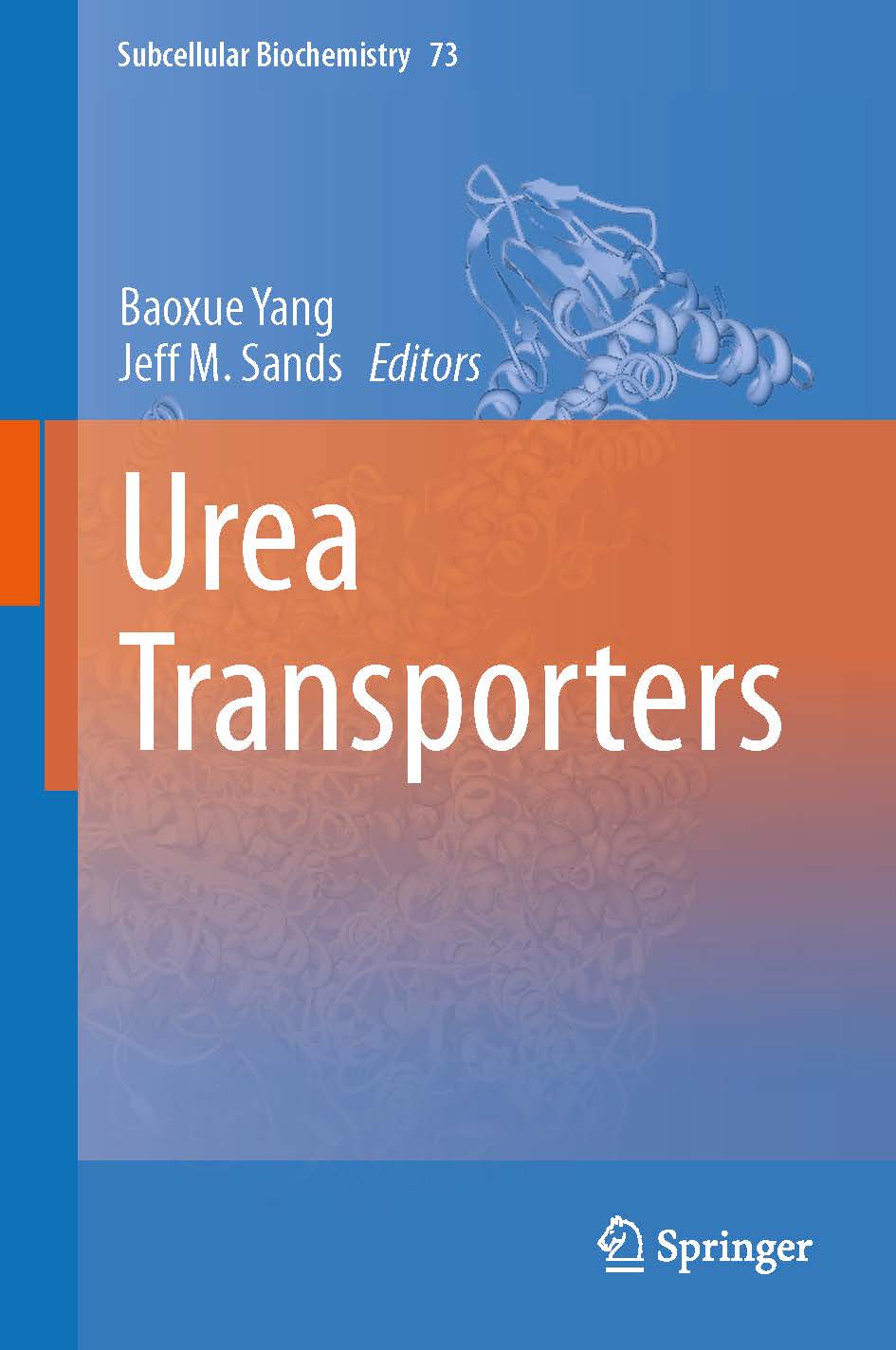北京大学基础医学院杨宝学教授主编的《Urea Transporters》一书出版

近日,北京大学基础医学院杨宝学教授和美国Emory大学医学院Jeff Sands教授共同主编的《Urea Transporters》一书由Springer出版社正式出版发行。该书是尿素通道蛋白(Urea Transporters)研究领域的第一本专著,Springer出版社特邀该研究领域的国际知名学者参与撰写,系统介绍了最近20年中尿素通道蛋白的发现历程、表达调控、生理功能、与疾病的关系和药理学研究进展。由美国国家健康研究所(NIH)肾脏领域资深专家Mark Knepper博士为该书作序。
尿素通道蛋白(UT)是一组特异性通透尿素的膜通道蛋白。目前已成功克隆了7个尿素通道蛋白成员,分别属于UT-A和UT-B两个亚家族。UT-A1~6由同一基因(Slc14a2)经不同启动子调控和转录后剪切产生。UT-B由Slc14a1基因编码产生。UT-A1~4在肾脏的不同部位表达,介导肾内尿素循环特定部位的尿素通透性,在肾内尿素循环过程中起重要作用,参与尿浓缩机制。UT-B广泛表达于肾脏、红细胞、脑、心脏、血管、脾脏、膀胱、输尿管、睾丸等多个组织器官。UT-B基因敲除小鼠表现出轻度抑郁样行为及雄性生殖系统早熟。流行病学调查发现UT-B基因突变与膀胱癌的易感性相关。
利用UT基因敲除小鼠模型进行的肾脏生理学研究结果表明,选择性敲除UT-A1/UT-A3、UT-A2或UT-B可阻断肾内尿素循环通路,降低尿浓缩能力,在不影响Na+、K+、Cl-排泄率的情况下,产生“尿素选择性利尿”作用,提示尿素通道蛋白可作为新的利尿药作用靶点,其抑制剂可研发成为新型利尿药。尿素通道抑制剂利尿作用的优点是不影响体液电解质平衡,适合高血压、心衰和水肿等慢性病患者长期使用。以尿素通道蛋白为靶点的药物发现近年来正逐步成为该领域的研发热点,新的作用机制和新的化合物亦都在不断发展之中。
延伸阅读:
施普林格(Springer)出版社是全球最大的学术与科技图书出版社,全球三大学术期刊出版社之一。从1971年起出版的《Subcellular Biochemistry》系列丛书,始终专注于介绍和推广细胞生物学及其相关领域的最新研究进展。所有章节均收录于MEDLINE/Pubmed。《Urea Transporters》为该系列的第73卷。全书共分14章,其内容包括尿素通道的发现与分子克隆、尿素通道蛋白基因结构、尿素通道蛋白晶体构象、尿素通道蛋白的组织分布、尿素通道蛋白表达调控、尿素通道蛋白转运尿素的数学模型、尿素通道的生理功能、尿素通道蛋白与疾病的关系、尿素通道抑制剂的利尿作用、主动运转尿素通道,以及参与尿素转运的水通道蛋白。
精装本:ISBN 978-94-017-9342-1
电子版:ISBN 978-94-017-9343-8,下载链接:
http://link.springer.com/book/10.1007/978-94-017-9343-8
出版社对该书的介绍原文
About this book
Covers research advances in the study of urea transporter over the past 20 years
Provides a systematic and comprehensive insight into urea transporters
Introduces clinical and pharmaceutical aspects of urea and urea transporters, linking the bench work to the bedside
Written by experts in this field
The mechanisms and physiological functions of urea transport across biological membranes are subjects of long-standing interest. Recent advances in the molecular biology and physiology of urea transport have yielded new insights into how and why urea moves across cell membranes. In the last two decades, seven facilitated urea transporters (UT-A1-6 and UT-B) have been cloned, and their gene organization, protein crystal structure, expression localization and physiological functions in the tissues have been described. In recent years, the studies in urea transporter knockout mouse models suggest that urea transporters may be useful targets for drug discovery of selective inhibitors. The modulation of urea transport activity by pharmacological agents may provide novel treatments for hypertension, congestive heart failure and other fluid-retaining states. However, although urea represents about 40% of all urinary solutes in normal human urine, the handling of this solute in the tissues has been largely neglected in the past, and few clinical or experimental studies now report data about urea. Most recent physiological textbooks include chapters on water and electrolyte physiology but not a single chapter on urea. Our aim in writing this book is to stimulate further research in new directions by providing novel and provocative insights into further mechanisms and the physiological significance of urea metabolism and transport in mammals.
The book provides a state-of-the-art report on the latest findings on urea transport and where the field is going. Although some older work is cited, the main focus is on advances made over the past 20 years with regard to the biophysics, genetics, protein structure, molecular biology, physiology, pathophysiology and pharmacology of urea transport in mammalian cell membranes. These aspects are especially valid, as advances in our understanding of urea transporting mechanisms and physiology promise to yield new insights into biology and medicine.
Keywords ?Membrane channel - Transporter protein - Urea - Urea transporter - Urine concentration
Related subjects ?Cell Biology- Human Genetics- Human Physiology- Pharmacology & Toxicology
(基础医学院药理学系)
编辑:韩娜


